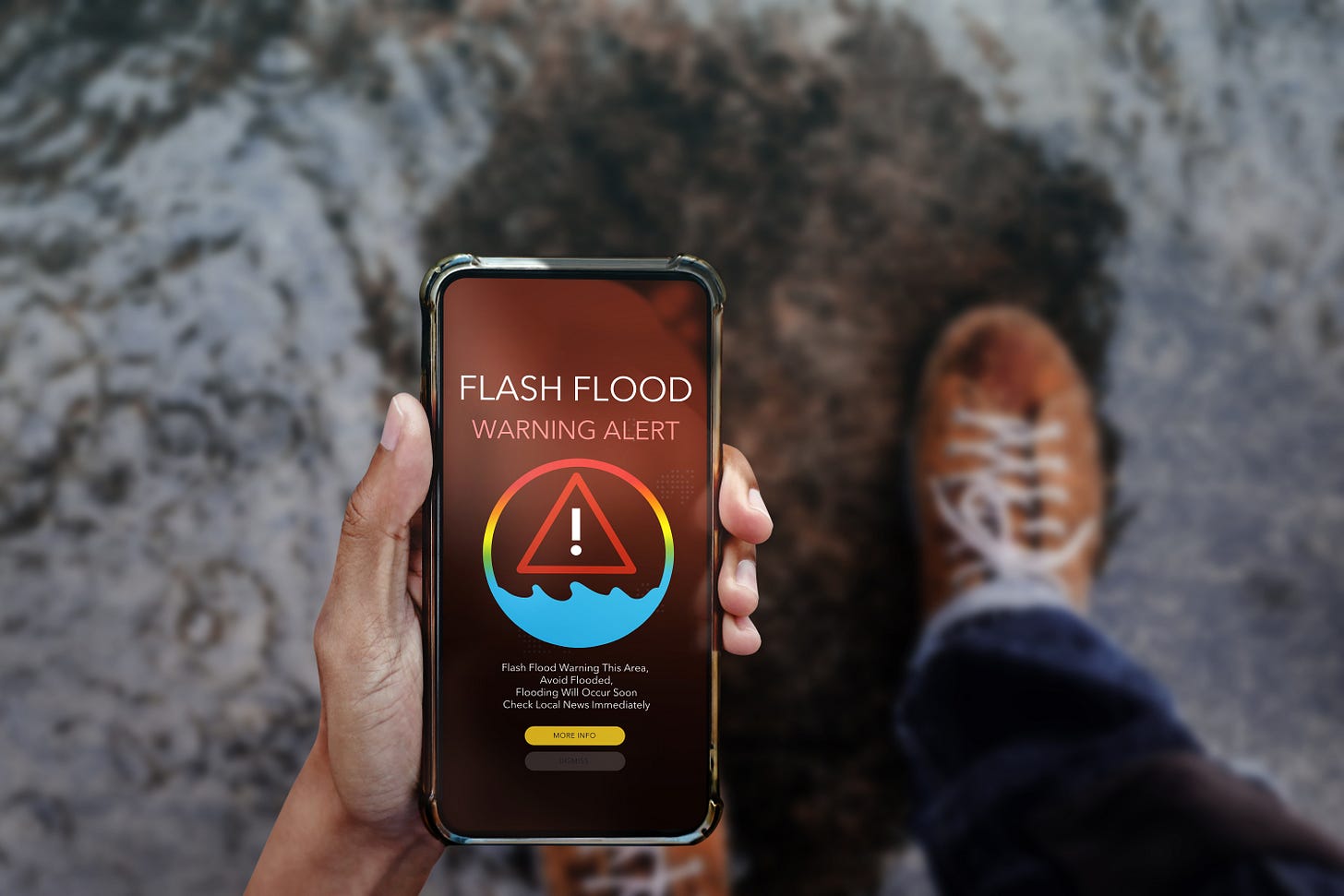Lead Before the Alert
The Texas floods remind us that readiness takes more than planning—it takes timing, judgment, and the courage to question what we think we know.
Over the past 10 days, I’ve watched, as I’m sure many have, with deep sorrow as Central Texas faced catastrophic flooding. As images surfaced—bridges overwhelmed, buildings overtaken, families displaced—the scale of the disaster was sobering. Yet for me, the most haunting part has not been the flooding itself, but the growing list of names—lives lost, families shattered.
As of this writing, 120 people are confirmed dead. One hundred seventy are still missing. These aren’t just tragic headlines—they’re reminders that behind every system failure, delayed decision, or underestimated threat are real people who bear the cost.
Having recently lived in Georgetown, north of Austin, I found the images from Central Texas especially difficult to watch. We crossed the Austin Avenue bridge over the San Gabriel River multiple times each week. This same bridge appeared in viral footage, with raging waters below, and a nearby apartment complex in danger of being submerged by floodwaters.
Typically, the San Gabriel sits quietly, 30 feet or more below that bridge. But on July 5, the river surged past its flood stage, cresting at 33 feet. Watching that video, it’s hard to reconcile the calm I once knew with the chaos that unfolded.
Fortunately, Williamson County, where Georgetown sits, saw far less loss of life than neighboring Kerr County. Only two deaths were confirmed in our former community. Property damage, while extensive, paled in comparison to the human toll in places like Camp Mystic, where the actual cost of the disaster was measured not in dollars, but in lives.
These events prompt urgent reflection. What can we—those responsible for teams, businesses, and communities—learn from this moment? What responsibilities do we hold when the stakes are this high?
The lessons below aren’t theoretical—they’re grounded in complex, sometimes heartbreaking realities. They are offered not as criticisms, but as guiding principles for any leader who might one day find themselves responsible for protecting others when the unexpected becomes unavoidable.
A Note to the Reader:
This reflection is not intended to place blame or criticize anyone directly involved with the organizations or individuals affected by this tragedy. In moments like these, countless people act with courage, compassion, and a sense of urgency. Rather, the intent here is to help others—especially those in leadership roles—learn from the event, reflect on their own readiness, and take proactive steps to better protect their teams and communities in the future.
1. Emergency Plans Must Be Operational, Not Just Documented
Camp Mystic, where 27 people died—including campers, counselors, and the camp’s owner, who died rescuing others—had just passed a state inspection, according to media reports, which included a reference to a documented emergency plan. Remarkably, over 750 people were on site at the time of the flood, and 96% of them survived.
However, the uncomfortable truth is that 96% isn’t good enough. Not when the 4% who didn’t make it were children, leaders, and loved ones with full lives ahead of them.
In my time leading large-scale operations, including portions of Disney’s transportation and parking systems, we worked under a clear expectation: “No one gets hurt.” That mindset shifts how you lead. It demands a higher standard—one where safety is non-negotiable and where contingency planning is grounded in real-world action, not theoretical compliance.
Emergency plans must be more than policies—they must be lived. They need to be clear, current, and tailored to the risks an organization may face, including fires, severe weather, and man-made threats. They should be informed by those who have led through past crises and understood at every level of the team.
Just as importantly, they must be drilled in a variety of conditions, not just during calm or convenient times. The 1987 flood in the same region occurred during daylight hours. The recent flood struck in the middle of the night, when visibility was limited, and when decision-making becomes exponentially more difficult. You can’t fully assess rising water or changing terrain in the dark. You’re relying on flashlights, instinct, and incomplete information.
That’s why plans must be practiced under different scenarios: in daylight and in darkness, in good weather and in bad, during waking hours and when most people are asleep. Because when it matters most, no one gets to choose the conditions—they just have to be ready to respond.
And most of all, they must be practiced until execution becomes second nature. In high-stress moments, people don’t rise to the occasion—they fall to the level of their training.

2. Leadership Must Move Faster Than Bureaucracy
It’s easy to point fingers in the aftermath. However, this event reminded us of something more fundamental: timing matters, and relying solely on public systems can be perilous.
Media reports indicate that the flash flood warning for the area, which included Camp Mystic, was issued at 1:14 AM on July 4. According to ABC News, campers had to be evacuated shortly thereafter as floodwaters began rising rapidly. But the emergency alert—the one with language like “SEEK HIGHER GROUND NOW”—didn’t arrive until a few minutes after 4:00 AM, according to the Austin American-Statesman. That gap proved fatal.
In one call shared by the media, a volunteer firefighter was heard asking for a “code red” alert. It reportedly took 90 minutes to receive authorization.
There’s no question that government systems matter. But there’s also no guarantee that they’ll act quickly enough. That’s not cynicism—it’s reality.
The lesson here isn’t to distrust the system. It’s to recognize that leadership doesn’t begin with permission. It begins with awareness and action. Leaders can’t always wait to be told what to do. When the indicators begin stacking up—when water levels rise, when storms stall, when alerts say “watch” but your instincts say “move”—we must be prepared to act.
Delaying a decision to relocate campers from low-lying cabins may have seemed prudent in the moment. Perhaps there were logistical concerns. Perhaps leaders were waiting for a stronger signal from weather authorities. But in hindsight, it’s clear that a moment of discomfort—sleeping arrangements disrupted, plans changed—would have been a small price to pay.

3. Familiarity Can Lull Us into Dangerous Assumptions
The third lesson is the quietest—and possibly the most dangerous.
It’s the belief that this can’t or won’t happen here.
While living in Georgetown, I saw flood alerts on my phone more than once. I’d dismiss them. “There’s no water nearby,” I thought. But what I didn’t realize was that the pond in my neighborhood flowed into a tributary, which fed into the San Gabriel River five miles away. That’s all it takes.
According to the US Geological Survey, the San Gabriel is usually about two feet deep. On July 5, it reached a height of over 37 feet. Two days later, it had returned to near normal. That kind of fluctuation reveals the power of water, as well as the power of false confidence. If we only prepare for what we’ve already experienced, we’re always one storm behind.
In Travis County, Cow Creek surged 16 feet in a matter of hours, according to local media reports. A bridge washed away miles from the Colorado River or Lake Travis. Geography didn’t save anyone.
As leaders, we must prepare people not just for what they expect, but for what is possible. That means challenging assumptions. That means asking uncomfortable questions. That means teaching teams to respond not based on familiarity, but on potential risk, even when it’s invisible.
Final Thoughts: Preparedness Is a Leadership Standard, Not a Crisis Strategy
Whether you’re responsible for a summer camp full of students and counselors, a fleet of vehicles, a transportation company, or a local business, the principles are the same. Planning must be practical. Action must be timely. Complacency must be challenged.
The deeper truth is that crisis leadership isn’t about moments of heroism—it’s about systems of preparedness. It’s about equipping people with the tools, judgment, and autonomy to act before disaster escalates. And it’s about creating cultures where safety is a collective value, not an individual responsibility.
The floodwaters in Texas will eventually recede. The headlines will fade. But what will endure is how we respond—how we lead, how we prepare, how we choose to improve.
To honor the lives lost, we must do more than remember. We must lead with greater clarity, courage, and conviction—so that when the next crisis arises, our teams are not only ready but also resilient.
Sources referenced include: media reports from The Texas Tribune, Austin American-Statesman, and KXAN, U.S. Geological Survey flood data, and National Weather Service timelines. This article is intended for educational and leadership reflection purposes.






